Looking for Yuzamashi info
I am wondering who uses a Yuzamashi for Japanese greens and what criteria they look for in one.
Do you use one that is twice the volume of the water amount you are brewing with?
What kinds of sizes do you have?
Glazed or unglazed?
Obviously wall thickness comes into play.
What about different shapes?
It's just a topic that I haven't seen too much about.
Maybe people just use the cups to pour back In to the brewing vessel, or even you only heat the water just right.
Please share some pictures of what you use, along with the pots you use them with.
Do you use one that is twice the volume of the water amount you are brewing with?
What kinds of sizes do you have?
Glazed or unglazed?
Obviously wall thickness comes into play.
What about different shapes?
It's just a topic that I haven't seen too much about.
Maybe people just use the cups to pour back In to the brewing vessel, or even you only heat the water just right.
Please share some pictures of what you use, along with the pots you use them with.
I have two, the one you see below, a 300ml-ish mogake Hokujo and a smaller 100ml mogake Hokujo with no handle. I mainly use the smaller one for gyokuro and sencha at night when I am drinking a smaller amount. As I minimize my life, I am realizing its a little redundant. They both cool and hold water, why two sizes?
I think I can say this here without too much ridicule, but I think I want one large one to serve for all tea types and vessels, but I want it to be handleless. I feel silly typing this, but I feel more connected to the pour with my small handleless yuzamashi. It's weird to say, but if anyone will understand it's other tea nerds.
I'm not too concerned with clay type, or glazing or not other than aesthetics.
One thing I like about having one main yuzamashi in rotation is learning the temps so you don't need a thermometer. For both my Hokujos, I hold my fingers right around the water line and how long I can hold my fingers until it starts to hurt will tell me the temp. 5 seconds is 146f, 4 seconds is 156f, 3 seconds is 166f and 2 seconds is 176f. I occasionally double check myself with a thermometer, but find it is accurate within a few degrees. Anything above or below really requires a thermometer for me, but since I mainly drink sencha, I stay within this range.

I think I can say this here without too much ridicule, but I think I want one large one to serve for all tea types and vessels, but I want it to be handleless. I feel silly typing this, but I feel more connected to the pour with my small handleless yuzamashi. It's weird to say, but if anyone will understand it's other tea nerds.
I'm not too concerned with clay type, or glazing or not other than aesthetics.
One thing I like about having one main yuzamashi in rotation is learning the temps so you don't need a thermometer. For both my Hokujos, I hold my fingers right around the water line and how long I can hold my fingers until it starts to hurt will tell me the temp. 5 seconds is 146f, 4 seconds is 156f, 3 seconds is 166f and 2 seconds is 176f. I occasionally double check myself with a thermometer, but find it is accurate within a few degrees. Anything above or below really requires a thermometer for me, but since I mainly drink sencha, I stay within this range.

I mostly control temps with my electric kettles, but use my yuzamashis for diluting overlong infused teas and cooling tea that I want to drink quickly by adding cold water.
My primary yuzamashi (on the left here) hasn't gotten much camera time

but it now lives permanently at work and is used daily when I am in that office.
I use a lovely celadon cup by Yi Yong Cheol as part of my usual travel set

My primary yuzamashi (on the left here) hasn't gotten much camera time

but it now lives permanently at work and is used daily when I am in that office.
I use a lovely celadon cup by Yi Yong Cheol as part of my usual travel set

If I get this right a Yuzamashi is what the Chinese would call a chahai, so I take the liberty to post what I use: it’s made from glass, as I do not want the material of the pitcher alter the taste of the tea. I prefer to let the teapot take care of that.
Why not porcelain you might ask? Porcelain comes in many different shades of white, while glass is neutral and matches most of my tea ware
Further added benefit is that the crackled glass and its reflections shows quite clearly the true colour of the brew (only pure white porcelain would otherwise, but pure white porcelain is often a bit to sterile in look to my eyes).
Why not porcelain you might ask? Porcelain comes in many different shades of white, while glass is neutral and matches most of my tea ware
Further added benefit is that the crackled glass and its reflections shows quite clearly the true colour of the brew (only pure white porcelain would otherwise, but pure white porcelain is often a bit to sterile in look to my eyes).
- Attachments
-
- A2B1FE49-53CB-4FEE-9182-25546698F033.jpeg (240.02 KiB) Viewed 10965 times
I never would.
I’ve heard that yuzamashi are for preparing gyokuro only, not sencha. This may be in a ceremonial context. However, I use mine for both as it’s a useful tool. Always as a water cooler and not a fair cup.
I'm a little confused. You seem to be using it for the brewed tea, and not clear hot water.Bok wrote: ↑Wed Feb 05, 2020 6:41 pmIf I get this right a Yuzamashi is what the Chinese would call a chahai...Further added benefit is that the crackled glass and its reflections shows quite clearly the true colour of the brew (only pure white porcelain would otherwise, but pure white porcelain is often a bit to sterile in look to my eyes).

I also would like to ask how glass can show true color when it is tinted by colors around it that it reflects or absorbs?
@rdl I do use it for both ways, it happens that the picture shows the use as a pitcher... I am not firm on Japanese tea protocol, yet the shape seems to be no different in principle than any other pitcher.
You would think that glass had this effect, but the way this particular pitcher is dented, it gives me a better idea of the true colour by moving and looking through it than porcelain which itself mostly still has some sort of tint.
You would think that glass had this effect, but the way this particular pitcher is dented, it gives me a better idea of the true colour by moving and looking through it than porcelain which itself mostly still has some sort of tint.
Yuzamashi is traditionally used as a cooling vessel for any Japanese tea, and was typically made as part of a set with a kyusu and five cups. I have four yuzamashi, three older ones that came as a set, another contemporary one that is a stand-alone, although it came with a larger cup and kyusu. They are all unglazed, and are made of the same clay, and have the same wall thickness, as the kyusu and cups. The sequence to cool heated water varies depending on how cool you want the water to get and local custom; sometimes hot water goes into the kyusu first, then yuzamashi, then into cups and, after filling kyusu with dry leaf, back into the kyusu. Other times, hot water goes into yuzamashi first, then cups, then into kyusu with dry leaf. With the second method, the kyusu is not preheated. I prefer preheating the kyusu because it brings out aromatics of the dry leaf.
One thing I find interesting is in older kyusu sets the yuzamashi is usually smaller than the kyusu and five cups. I think the kyusu is not intended to be used to full capacity, and cups are intended to be filled only halfway or less. I’ve become accustomed to the ease of using an electric variable temperature kettle, and since I have several beautiful yuzamashi that I love handling, I now use them in a non-traditional way to measure dry leaf on a scale. The indented spout makes pouring dry leaf into a kyusu super easy. But when I do use a Tetsubin or clay kettle, then I’ll use a yuzamashi as intended to calibrate water temperature for Japanese teas.
My avatar is a yuzamashi from a Tokoname mogake set by Koudou Studio that Chitoshi Morita (1931b) ran. It holds a special place for me, being the first of several kyusu that I acquired at the LA Aikido Center auction from the collection of the center's founder, Sensei Rev. Kensho Furuya.
Koudou Studio, Chitoshi Morita (1931b.) Hakudei (white clay) mogake
Yuzamashi: 75ml
Kyusu: 180ml
Cups: 25-30ml X 5
Banko ‘diamond cut’ champhered set, Shidei (purple clay) reduction fired
Yuzamashi: 100ml
Kyusu: 250ml
Cups: 40-45ml X 5
Hokujo kiln, Shimizu Genji (1945 b.) early production twisted spout, Shudei (red clay) set
Yuzamashi: 150ml
Kyusu: 230ml
Cups: 30-35ml X 5
Taisuke Shiraiwa (1985 b.), Hakudei (white clay) with added sand particles. Kyusu is Shudei clay.
Yuzamashi: 160ml
Kyusu: 220ml
Cup: 110ml
I also use Taisuke’s yuzamashi as a server. It’s more vertical flared form, light clay and larger size makes it very pleasant to use this way.
One thing I find interesting is in older kyusu sets the yuzamashi is usually smaller than the kyusu and five cups. I think the kyusu is not intended to be used to full capacity, and cups are intended to be filled only halfway or less. I’ve become accustomed to the ease of using an electric variable temperature kettle, and since I have several beautiful yuzamashi that I love handling, I now use them in a non-traditional way to measure dry leaf on a scale. The indented spout makes pouring dry leaf into a kyusu super easy. But when I do use a Tetsubin or clay kettle, then I’ll use a yuzamashi as intended to calibrate water temperature for Japanese teas.
My avatar is a yuzamashi from a Tokoname mogake set by Koudou Studio that Chitoshi Morita (1931b) ran. It holds a special place for me, being the first of several kyusu that I acquired at the LA Aikido Center auction from the collection of the center's founder, Sensei Rev. Kensho Furuya.
Koudou Studio, Chitoshi Morita (1931b.) Hakudei (white clay) mogake
Yuzamashi: 75ml
Kyusu: 180ml
Cups: 25-30ml X 5
Banko ‘diamond cut’ champhered set, Shidei (purple clay) reduction fired
Yuzamashi: 100ml
Kyusu: 250ml
Cups: 40-45ml X 5
Hokujo kiln, Shimizu Genji (1945 b.) early production twisted spout, Shudei (red clay) set
Yuzamashi: 150ml
Kyusu: 230ml
Cups: 30-35ml X 5
Taisuke Shiraiwa (1985 b.), Hakudei (white clay) with added sand particles. Kyusu is Shudei clay.
Yuzamashi: 160ml
Kyusu: 220ml
Cup: 110ml
I also use Taisuke’s yuzamashi as a server. It’s more vertical flared form, light clay and larger size makes it very pleasant to use this way.
